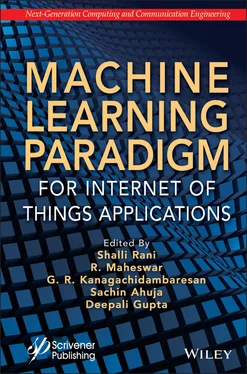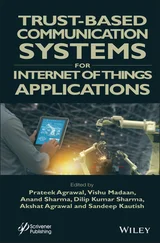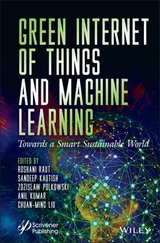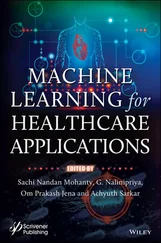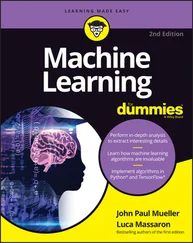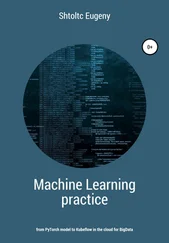Machine Learning Paradigm for Internet of Things Applications
Здесь есть возможность читать онлайн «Machine Learning Paradigm for Internet of Things Applications» — ознакомительный отрывок электронной книги совершенно бесплатно, а после прочтения отрывка купить полную версию. В некоторых случаях можно слушать аудио, скачать через торрент в формате fb2 и присутствует краткое содержание. Жанр: unrecognised, на английском языке. Описание произведения, (предисловие) а так же отзывы посетителей доступны на портале библиотеки ЛибКат.
- Название:Machine Learning Paradigm for Internet of Things Applications
- Автор:
- Жанр:
- Год:неизвестен
- ISBN:нет данных
- Рейтинг книги:4 / 5. Голосов: 1
-
Избранное:Добавить в избранное
- Отзывы:
-
Ваша оценка:
- 80
- 1
- 2
- 3
- 4
- 5
Machine Learning Paradigm for Internet of Things Applications: краткое содержание, описание и аннотация
Предлагаем к чтению аннотацию, описание, краткое содержание или предисловие (зависит от того, что написал сам автор книги «Machine Learning Paradigm for Internet of Things Applications»). Если вы не нашли необходимую информацию о книге — напишите в комментариях, мы постараемся отыскать её.
As companies globally realize the revolutionary potential of the IoT, they have started finding a number of obstacles they need to address to leverage it efficiently. Many businesses and industries use machine learning to exploit the IoT’s potential and this book brings clarity to the issue. Machine Learning Paradigm for Internet of Thing Applications
Machine Learning Paradigm for Internet of Things Applications — читать онлайн ознакомительный отрывок
Ниже представлен текст книги, разбитый по страницам. Система сохранения места последней прочитанной страницы, позволяет с удобством читать онлайн бесплатно книгу «Machine Learning Paradigm for Internet of Things Applications», без необходимости каждый раз заново искать на чём Вы остановились. Поставьте закладку, и сможете в любой момент перейти на страницу, на которой закончили чтение.
Интервал:
Закладка:
The aim of the architecture is to provide numerous APIs as well as visual web services with public smart city information via data [13]. In this particular instance, the system design can make it easy to transmit sensor data to a back-end system and be incorporated into the “standard” city monitoring system.
1.5.3 Transporting Networks to Facilitate
Multiple major companies, such as OLA, Uber, and the car manufacturers, are increasingly developing autonomous vehicles. For self-parking vehicles, the Indian Department of Transportation has just paved the way. This are projected to be on the market and generally available as early as 2020, likely with significant market shares. More users in the city nowadays are using the private transport more than the public transportation such that it has some effects in the public transportation and lead to more pollution around the economical city [16]. They should encourage the public mode of transportation to others and to help the environment.
It is possible that traffic control in a smart city would be drastically different. Future methods would be collaborative, unlike the individual driver-focused current solution, where the aim is to maximize flow in a road system. This could include a drop in waiting times for traffic lights and average delay, a decrease in mean cumulative travel time, or an increase in overall highway productivity. Traffic management now also uses traffic light networks that track road traffic with timers and sensors [17]. Efforts are being made to develop software that can forecast traffic flows, a smart trip simulation system built on the neural network that can simulate speed profile conditions with a high degree of accuracy at various sensor locations.
1.5.4 Control Centers for Governing the City
Recognizing these threats and prospects, the government of India initiated the 100 Smart Cities Mission in June 2015. Almost 100 smart cities have been established since the mission was launched and cities have begun to implement public infrastructure and ICT initiatives according to mission guidelines. Cities have conceptualized projects that enable them to do more, increase their organizational effectiveness, and provide residents with timely and reliable services.
1.5.5 Integrated Command and Control Center
The Integrated Command and Control Center (ICCC) serves as the “Nerve Center” for Operations Administration, Day-to-Day Exception, and Crisis Management. It also provides insights through the analysis of diverse aggregated data sets to produce information for better planning and policy making. The ICCC is intended to aggregate information through various applications and sensors distributed across the region and then provide actionable information with sufficient representation for decision-making. Although few cities have begun implementing ICCC with necessary software, networks, and sensors under the Smart Cities Mission, they are at different stages of maturity as far as informed decision-making is concerned [19]. As these ICCCs are introduced, it is imperative to assess the sophistication of productivity using a common methodology across the world ensuring that improvements made by cities can provide sufficient benefits for cities and people in the future.
While few cities have begun to deploy ICCCs with the necessary software, networks, and sensors under the Smart Cities Mission, they are at different stages when it comes to informed decision-making. As these ICCCs are introduced, it is imperative to assess the sophistication of productivity using a common methodology across the world ensuring that improvements made by cities can provide sufficient benefits for cities and people in the future. The purpose of this evaluation system is to provide communities with a do-it-yourself toolkit to measure the maturity and efficacy of the Centralized Command and Control Center in municipal operations management, day-to-day emergency management, crisis management, preparation, and policy-making.
It is envisaged that the ICCCs would be the brain of metropolitan service, exception handling, and crisis management [19, 20]. Figure 1.6shows the smart city control flow for command and control centers. Sensors and edge devices can collect and produce real-time data from different services such as water, waste management, electricity, accessibility, the urban environment, education, health, and safety.

Figure 1.6 Smart city control flow for command and control centers.
The ICCC used to the following:
1 Enhanced understanding of circumstances by providing information through sensor deployment across the city for civic officials through urban functions.
2 Standardizing urban response protocol by developing modern protocols for repeated incidents, complaints, and requirement scenarios.
3 Strengthen cooperation inside and beyond various agencies local urban bodies and municipal authorities.
4 Institutionalization of daily activities decision-making guided by evidence and in the case of a crises around the city level—from the owners to the city managers.
5 Engaging on-site service workers in dealing with social concerns and residents’ complaints.
1.6 Heritage of Culture Based on Modern Advancement
India’s growth mechanism has been affected, in part, by the transnationalization of capital within the global economy, which has enabled the deployment of capital and labor within India by both foreign financing institutions (e.g., the World Bank) and private multinational companies (e.g., Union Carbide). In order to sustain capital-intensive modes of industrial and agricultural production, the Indian economy depends on foreign technology and finance [23]. As a result, the Indian state has accrued a huge foreign debt with both the US and the USSR and has encouraged a phase of growth that has a significant effect on the relationship within its borders between the state and the different indigenous cultures.
The state is not an individual fact, of course. It is composed of organizations tied, in turn, to the international economy. Therefore, amid some external financial and technical dependency, the dominant classes of India’s state capitalist system, namely, the bureaucratic elite and the governing alliance of the national bourgeoisie (large private enterprise), the army, wealthy peasant farmers, small traders, and money lenders, are steering indigenous production in India.
Western models of production, growth, and transformation, which in part view rural development as an issue of sectoral development based on an industrial urban economy, have profoundly shaped the ideological paradigm of development embraced by the state. India has been subject to a modernization phase that has already evolved in the West due to its reliance on international technologies and finance and its acceptance of western growth models.
An unjust cultural exchange that emphasizes Western traditions and devalues indigenous forms of knowledge has preceded the unequal economic exchange that occurs between industrialized capitalist states and developing nations. In the emphasis put on modernity within the development phase in India, this Western bias is evident [24]; it equates modern scientific rationality and technology with an effective process of development and devalues non-modern societies and their conventional information structures.
1.7 Funding and Business Models to Leverage
The business model is a very new term, and even though it is commonly debated, there is a lack of a common description. A business model defines the reasoning for creating, providing, and capturing value (economic, social, cultural, and other sources of value) through an entity. A business model concerns “the design of goods, facilities, and knowledge flows”, one of the most commonly known concepts derives from. This definition considers players, functions, market potential, and revenue streams. Four elements and positions, the meaning proposal, are in the middle of the business model structure or “canvas”. While multiple value ideas could be put forward, business models can be ranked in five different trends according to the following:
Читать дальшеИнтервал:
Закладка:
Похожие книги на «Machine Learning Paradigm for Internet of Things Applications»
Представляем Вашему вниманию похожие книги на «Machine Learning Paradigm for Internet of Things Applications» списком для выбора. Мы отобрали схожую по названию и смыслу литературу в надежде предоставить читателям больше вариантов отыскать новые, интересные, ещё непрочитанные произведения.
Обсуждение, отзывы о книге «Machine Learning Paradigm for Internet of Things Applications» и просто собственные мнения читателей. Оставьте ваши комментарии, напишите, что Вы думаете о произведении, его смысле или главных героях. Укажите что конкретно понравилось, а что нет, и почему Вы так считаете.
